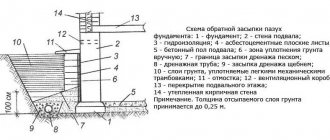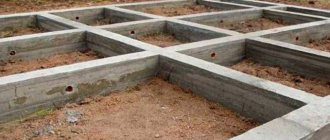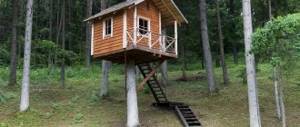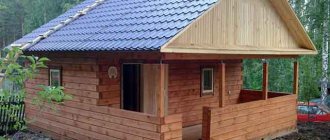The cost of a foundation on piles Pile foundation for a garage Foundation on piles
Our company is engaged in driving reinforced concrete piles, as well as leading drilling for piles. We are ready to help you and carry out these types of work in the shortest possible time and at a low price. In this article we will talk about the advantages and disadvantages of foundations on screw piles. Foundation on screw piles: advantages and disadvantages, screw piles used, as well as calculation of foundation on screw piles. Detailed information on the website page.
You will learn what materials are needed to build such a foundation, how it is calculated and arranged. We will also get acquainted with the main types of screw piles used in low-rise construction.
Types of screw piles for screw foundations
To construct a foundation on screw piles, pile pillars of one of four common forms can be used:
Fig: Types of screw piles
- Option No. 1 - single-blade piles, which are used to construct foundations in normal soil conditions for lightweight houses made of frame panels and wood;
- Option No. 2 - piles equipped with several turns of blades, due to which they have increased load-bearing capacity and resistance to shrinkage and pull-out effects. On foundations made from such piles, one-story foam concrete buildings or two-story houses made of lightweight materials can be erected;
- Option No. 3 - structures with narrow blades, used for screwing in areas with rocky soils, are used for the construction of light houses;
- Option No. 4 - structures intended for use in permafrost conditions, the scope of application is similar to narrow-bladed piles.
After installation, piles of any type are equipped with a steel cap, which is used as a support platform on which the foundation frame is subsequently located. The headrests are a cut of a cylinder, to the top of which a square platform measuring 25*25 cm is welded.
Fig : Heads for screw piles
To combine free-standing screw piles into a single system, they are tied. The structure connecting the piles is called a grillage; it can be formed either by pouring a monolithic reinforced concrete strip or from timber or rolled metal - an I-beam or channel.
Fig : Types of grillages for tying screw piles
How is a pile foundation constructed?
A pile foundation is a supporting structure for a building, consisting of free-standing piles or a pile field. They are usually made of reinforced concrete, but it is possible to use non-reinforced concrete or rubble concrete, which somewhat reduces the cost of the structure. To increase strength and save concrete, the pile foundation is reinforced. Rods made of smooth or profiled steel are usually used as reinforcement. Foundation piles must be installed at the corners of the building, at the intersection of internal load-bearing walls with each other and with external walls. If the distance between the required piles is from 2 to 2.5 m or more, then intermediate ones are also installed between them.
Which screw piles are best to use?
All screw piles used in private construction are divided into types based on the manufacturing technology of their tip, according to which welded and cast structures are distinguished.
The cheapest are piles made using welded technology. In this case, their tip is simply welded to the main rod. Due to the simplicity of this production method, such piles are manufactured everywhere - from large factories to small private workshops, which causes a wide range of their quality.
Fig : Screw pile with a welded tip
Welded screw piles are used for driving into low-density soils - clay, loam, sandy loam. If, when screwing in, their blades collide with a solid obstacle (a piece of rock or a tree root), the screw may become deformed or come off. As a result, the pile will lose its load-bearing capacity and cannot be used as a support for the house.
| Expert advice ! We do not recommend ordering welded screw piles blindly, or according to an image on the Internet, since in this case you may encounter serious troubles - in most cases, shrinkage of the base on screw piles is not associated with an erroneous calculation of the foundation, but with the tearing off of poorly welded blades when submersion, which unscrupulous contractors responsible for the work often do not inform the customer about. |
Fig : Deformation of the welded tip of the screw pile
The technology for manufacturing piles with a cast tip, when the entire structure is created by pouring a mold with metal, is much more expensive to implement. Such piles are much more expensive, but in terms of quality and reliability they are superior to welded products in all respects.
The standard diameter of the blades of cast screw piles used in individual construction is 30 centimeters, while the thickness of the steel from which the blades are formed can reach up to 1 cm. The shaft of the structure, as in the case of welded options, is made of a steel pipe with a wall thickness of not less than 0.4 cm, its diameter can vary from 5 to 15 cm. The weight of such a structure, with a length of 2.5 meters, is 35 kilograms.
Fig : Screw piles with a cast tip
The advantages of cast piles include the possibility of more precise positioning of the trunk when screwing - unlike welded structures, they are not prone to distortion when immersed, and collisions with stones and tree roots do not cause any harm to the tip.
| Expert advice ! Preference should be given to piles with a galvanized shaft; thanks to the protective coating, they are practically not subject to corrosion under the influence of groundwater, and their service life is several decades longer than the service life of ferrous metal piles, even if they are treated with an anti-corrosion primer. |
See also
Construction of pile foundations and their insulation.
Monolithic pile foundation
What are the advantages of a pile foundation?
Construction of houses
37 votes
+
Vote for!
—
Vote against!
One day, while preparing a foundation pit, you discovered that the soil became weaker as it went deeper, instead of becoming more compacted with depth. If, in the end, you have reached a solid foundation, then the least expensive and easiest solution is to place a strip foundation. But in the case where weak soil is located below reasonable limits, it is more advisable to arrange other types of construction, one of which is a pile foundation.
The concept of a pile foundation
For a long time, in an area that was often flooded, people built houses on stilts driven into the ground. The piles were made from logs and driven manually into the soil - although such a process took a lot of effort and time from the developers, it nevertheless made it possible to raise the house by a meter or two and save property from water.
The pile foundation is still very popular when it is necessary to build a building on weak soil, low strength or highly compressible, that is, on such soil that it is not suitable for a conventional shallow foundation.
The pile foundation is characterized by many advantages and is considered one of the most reliable structures among builders. If we compare pile and column foundations, the technology of pile foundations is much simpler, because there is no need to dig holes, fill cavities and make formwork.
When constructing a pile foundation, it is sometimes possible to do without excavation work - the piles are usually driven into the ground using special equipment, and wells for bored piles can be drilled using a hand-held construction drill.
Pile foundations have found wide application in civil and industrial construction. The use of a pile foundation helps to reduce the work on constructing the basement of buildings, or even eliminates this from construction work. Pile foundations are used with great success in the construction of cottages, country houses and country houses.
Reasons for choosing pile foundations
What may be the reason for the construction of a pile foundation during the construction of a country house? The main reason is weak topsoil. Weak soils include plant soils with peat or humus, loess-like soils that lose stability in the presence of water, sandy-clayey quicksand soils that are highly saturated with water, loams and clayey soils in a current and plastic state.
In the situations described above, there is a need to transfer the load from the building to denser soil, which is located at depth. A pile foundation also allows you to cope with heaving soils.
Another reason on the other hand is construction in dense soils. Pile foundations can be used to reduce the volume of excavation work and the costs that such work can provoke - removal of soil after digging a pit, backfilling and further concreting.
If you decide to build a foundation with little labor and quickly, then building a pile foundation with your own hands for these purposes will come in handy. To install a pile, which is 3 meters long and 30 centimeters in diameter, you need to dig 0.2 cubic meters of earth. In the case of choosing a strip foundation, the volume of earthworks will be significantly greater.
If you choose a foundation based on the type of load-bearing frame, for example, if a frame frame is used on soft soil, then it is more rational to arrange not a strip foundation, but pile “bushes” under the columns.
Pile foundation structures
There are many types of pile foundations, depending on the type of piles used and the method of their manufacture, the location of the piles under the structure, the level of immersion of the piles into the soil and the design of the grillages. You should focus your attention exclusively on those pile foundation structures that the developer can create with his own hands.
Piles are long rods that are sunk into the soil ready-made or manufactured directly into the soil. On one side, the finished piles have a pointed end, which is usually sharpened and protected with a steel tip from various damages when immersed in the soil. A steel ring is placed on the upper end to prevent the pile from splitting from hammer blows. Regarding the piles being manufactured, a similar technique involves drilling wells with reinforcement and then pouring the concrete mass.
According to the method of immersion into the ground, piles are divided into:
- driven ones, which are driven using vibrating hammers and similar pressing mechanisms;
- drilled reinforced concrete piles, which are installed in drilled wells;
- cast-in-place concrete piles and reinforced concrete piles, which are created by drilling a well and pouring concrete;
- screw piles, which are installed by screwing a drill-shaped pile into the soil.
According to the method of impact, piles are:
- hanging piles, which transfer the load by friction of the earth against the walls of the piles;
- racks that transfer the load to strong soil, which is located under a layer of weak soil. This foundation gives almost no precipitation.
According to the principle of location, there are piles:
- single, which act as a free-standing support;
- combined into pile strips that are located along the perimeter of the walls and distribute the load evenly;
- combined into pile bushes that are placed under the columns of the load-bearing foundations of buildings.
Location and materials of piles
Regarding the drawing of the pile foundation and the location of the piles, they are usually placed strictly vertically, but there are also options for the inclined arrangement of the piles. Such solutions are usually used in soil with horizontal forces, for example, on the site under the influence of long-term precipitation or spring melting, forces may arise that cause soil movement.
Materials used to make piles:
- Tree. Wood piles are cleaned, even pillars with a diameter of up to 34 centimeters and a length of up to 8.5 m. Hard coniferous wood (larch, pine, spruce and fir) is used for products. Wooden piles are considered the cheapest method, but it is rarely practiced. This is due to the wood's susceptibility to rapid rotting. However, using wood processing preparations available on the market today, such a technique has the right to life.
- Steel. Such piles have many disadvantages. Firstly, crane equipment is required if the pipe diameter is more than 10 centimeters and the length is more than 3 meters. It is also necessary to treat the metal most carefully using an anti-corrosion coating. In addition, this method requires large amounts of metal.
- Reinforced concrete. The advantage of these piles is the possibility of their implementation directly on site, if the appropriate equipment is available. For the manufacture of such piles, concrete of at least M200 marking is used. The useful life of reinforced concrete piles is more than 100 years.
The best options for private suburban construction are solid reinforced concrete products, screw steel and cast-in-place concrete piles. The most preferred solution for deepening is called the drilled method.
Pile foundation construction technology
If we compare the method of constructing a columnar foundation, which requires digging holes with slopes, creating formwork and filling cavities, then the technology for constructing a pile foundation is more technologically advanced. The foundation in general involves drilling a well of a certain diameter, installing reinforcement into it and pouring concrete into the created hole. The big advantage of this option lies in the fact that you can drill a well with a hand-held construction drill.
Well drilling
The number of bored piles that will be located along the perimeter of the building and fixed in the plan of the pile foundation should be determined based on the weight of the future residential building along with operational loads. The parameters of internal piles can be determined taking into account the loads created by the floor, roof, partitions and operational loads.
When making calculations, you must not forget that the maximum possible diameter of a hand drill that can be used manually should reach 300 millimeters; similar drills are available in a large assortment for free sale. You can adjust the length of the drill rod, and this, in turn, allows you to drill wells up to 5 meters deep and more.
The cutting blades of the drill are positioned in such a way that the applied forces during drilling are minimal. Construction equipment for manual drilling is now being produced, which makes it possible to significantly widen the lower part of the well. At the same time, a support heel for the pile is obtained, which allows you to effectively reduce the number of piles and save concrete.
If you need to drill a well with a diameter of 500-600 millimeters, then it is customary to use motorized and electric drills. For example, an electric pit drill, which is used to drill a well for the installation of high-voltage lines and helps to obtain a well with a diameter of up to one and a depth of up to four meters.
Concreting and reinforcement of piles
After the wells have been drilled, you need to look at the manual about the pile foundation and make pipes from roofing material according to the diameter of the well, which have a length of 200-300 millimeters greater than the depth of the hole. The upper part of the “pipe” must be made of two or three layers of roofing felt, then pulled together using soft steel wire. This part will become the formwork. Then carefully insert the pipe into the well.
If there is a small amount of water at the bottom of the well, then you do not need to pay attention to it. However, if the water is more than 1/4 of the depth of the hole, then it should be pumped out before pouring concrete.
If you do not use the so-called “pipe,” this will provoke negative results that affect the strength of the foundation pillars. When concrete sets and gains strength, the presence of “cement laitance” in the concrete mass remains of great importance, and it can easily go into the soil, and as a result, the design strength will not be achieved.
The forces of frost heaving when the soil freezes will act much stronger on the rough walls of the pile, which are obtained by pouring concrete into the pit without installing a pipe, than on smoother ones using a “pipe”.
When the well is made, to increase the strength of the pillars, you need to make a spatial reinforcement frame. Three vertical rods of reinforcement with a diameter of 6 millimeters are enough, which are fastened together every 500-600 millimeters with crossbars.
Vertical rods for connecting the pillars and the grillage must be brought above the poured products to a height that is equal to the height of the grillage minus two to three centimeters. After installation, concrete (40 - 60 centimeters) is fed into the frame well, and it is compacted using vibrators.
Grillage arrangement
The grillage of a pile-type foundation is a structure that unites the piles and ensures uniform distribution of loads on the soil and piles. Grillages are prefabricated, monolithic and prefabricated-monolithic, as well as high and low. Low grillages are placed buried in the ground, and part of the vertical loads are transferred to the soil. Regarding high grillages, their load is completely transferred to the piles.
On piles, the grillage is made monolithic or from prefabricated reinforced concrete beams. For light houses, the recommended grillage parameters are as follows:
- height - not less than 300 millimeters;
- when placing piles in a single row, the width is taken equal to the width of the base; if there is no base, the thickness of the wall of the first floor, but not less than 400 millimeters.
It is not allowed to cut or cross the grillage with sanitary pipelines. The deviation from the vertical position of the centers of the piles after concreting or immersion should not be more than 5 centimeters.
When installing prefabricated elements, you should definitely watch a video about a do-it-yourself pile foundation and pay special attention to securing it to the pile head. In the process of filling the cavity of the cast-in-place pile with concrete mixture, a T-shaped reinforcing bar is concreted vertically. The next reinforcing bar must be laid horizontally on the pile head.
The length of such a rod should be equal to the width of the pile with limiter plates that are welded on both sides. Their height should be sufficient to grip the pile and the grillage element that is being mounted. Then the assembly joint is usually concreted, and the short vertical bars are welded to the mounting hinges of the grillage using reinforcing bars of the desired length.
When replacing a prefabricated grillage beam with reinforced concrete load-bearing lintels, it is recommended that they be secured together by welding using reinforcing bars or tied with twisted wire. After the grillage is constructed, all seams and joints must be filled with cement mortar or fine-grained concrete.
Before erecting the walls of a residential building, you need to check the marks of the upper plane of the grillage and, if necessary, level it with cement mortar under the installation horizon. To do this, you can use a level or water level. Checking the dimensions of the grillage and the squareness of the plan is finally measured by its diagonals and sides.
Limitations on the use of pile foundations
Despite all the advantages and cost of a pile foundation, these structures also have their drawbacks, or, to be more precise, restrictions that prevent their use, namely:
- Pile foundations are bad in horizontally moving soil, which includes subsidence and swelling soils. The nature of the land can only be determined through laboratory testing, which will require detailed geological investigations due to the insufficient level of resistance to overturning.
- When installing a pile foundation, difficulties arise with the construction of the base. The space between the piles needs to be filled (backed up) as in the construction of columnar foundations. And this is an additional expense of money and effort.
Thus, you know in what cases it is worth installing a pile foundation on your land plot, and how to make a pile foundation. When choosing a foundation for your own residential building, you need to think carefully about all the possible pros and cons in order to make a final decision. If you don't understand everything, a pile foundation can not only turn out to be the ideal solution in construction, but also become the biggest mistake.
Foundation on screw piles technology
The technology for constructing a foundation on screw piles is implemented in several successive stages. Let's consider each of them.
- Construction site analysis
First of all, geodetic studies are carried out, which are necessary to determine the type of soil at the construction site and the level of groundwater.
| Expert advice ! Based on the type of soil, the type of screw piles used and the depth of screwing are determined - the supporting blades of the pile should be located in the deep layer of soil, only in this case can there be no risk of foundation shrinkage. |
Fig : An example of a house on screw piles built on a sloping site.
The height difference at the construction site is also analyzed - unlike any other types of foundations, a pile-screw foundation does not require preliminary leveling of the site, since a uniform height of the caps can be obtained using piles of different lengths, the trunks of which They are simply trimmed to the same level.
- Preparatory work.
This stage consists of delivering materials and equipment to the construction site, storing them, wiring all necessary communications - electricity, lighting, and marking the pile field.
- Screwing and cutting piles.
Upon completion of marking the places for immersion of piles, they are screwed.
For this purpose, self-propelled units based on truck cranes are used, on the boom of which a capstan is installed - hydraulic equipment consisting of a rotator, a diesel drive and reaction levers. Fig : Capstan for screwing screw piles
The sequence of driving a screw pile is as follows:
- The tip of the capstan is installed on the shaft of the pile, the structure is fixed with a pin through special mounting holes;
- By moving the jib crane, the pile is installed at the immersion site, and the reaction arms of the capstan are connected to it;
- The operator turns on the equipment and the pile is screwed in. The immersion speed of the structure is adjusted by changing the speed of the diesel drive of the rotator.
| Expert advice ! The equipment for screwing piles has a reverse motion, which allows you to quickly dismantle the screw pile if it deviates from the required trajectory, and perform re-driving. |
Fig : The process of driving a screw pile
After screwing in all the piles, the tops of the trunks are trimmed to the design level. This is done using a pile cutter mounted on a jib crane instead of a capstan, or using a regular grinder.
- Concreting the trunks and tying with a grillage.
The hollow shafts of screw piles are filled with concrete mortar of grades M200-M300, this is necessary to prevent corrosion of the walls from the inside and increase their load-bearing capacity of the piles. Next, metal heads are welded to the trunks, and the welded joints are necessarily coated with protective primers.
Fig : Tying screw piles with a steel grillage.
The last stage of installation is tying the piles with a grillage. To do this, a channel or I-beam is welded to the heads. The tying is carried out both along the external and internal contours of the pile field. During further construction, the grillage serves as the foundation on which the walls of the house are erected.
Advantages of construction using pile-screw technology
The construction of buildings based on this type of foundation has significant advantages.
Reducing work completion time
When using piles, construction time is significantly reduced for a number of reasons:
- negative temperatures and cold seasons are not an obstacle to installing piles. There is no need to wait for favorable conditions;
- piles of this type are not subject to shrinkage. The screw foundation does not require “standing”, unlike concrete foundations;
- the simplicity of the technology minimizes labor costs at the installation stage;
The presence of various models of piles, differing in type of construction, diameter, and blade size allows you to quickly make calculations and select the best option for a particular object, taking into account its features.
Economical
Piles are cheaper than materials for other types of foundations, and the simplicity of the technology reduces construction costs. Installation of supports of this type does not require expensive rental of heavy equipment, and in some cases (light buildings, small pile field) the foundation can be built with manual screwing.
Possibility of construction next to existing structures
The construction of a pile-screw foundation is not associated with vibration and other phenomena that can harm existing buildings, so a foundation of this type is the optimal solution for construction if you plan to build a structure or fence next to a residential building. The piles are screwed in without damaging the soil. A pile-screw foundation is ideal for the construction of extensions or verandas.
Calculation of foundations on screw piles
To prevent significant shrinkage of the supports, it is necessary to carry out a structural calculation before building the foundation. is carried out in three stages :
- calculation of grillage strength and selection of support material;
- calculating soil strength;
- calculation of screw piles.
The diameter of the piles used is determined based on the load-bearing capacity of the structure and the design weight of the building being constructed.
In individual construction, trunks with a diameter of 89 and 108 mm are most often used. The bearing capacity of a pile with a diameter of 89 mm, according to current standards, should not be less than 5 tons. On such piles it is possible to build foundations for small lightweight buildings made of frame panels. For the construction of houses made of timber, foam concrete and logs, piles with a diameter of 108 mm are used, with a load-bearing capacity of 7 tons.
Fig : Diagram of a screw pile with a diameter of 108 mm.
The length of the piles used is calculated based on the height differences at the construction site and the seasonal depth of soil freezing. In conditions of a flat construction site, piles 3-3.5 meters long are used; at different levels of relief, trunks of different lengths can be used in one foundation.
| Expert advice ! To calculate the number of piles required, it is necessary to divide the mass of the building by the load-bearing capacity of one pile. As a rule, pile supports are placed at intervals of 2.5-3 meters from each other. |
What you need to know before starting work:
- dimensions and weight of the future home;
- weight of the building;
- groundwater level and the likelihood of flooding (for houses located near water bodies);
- soil type and degree of chemical activity;
- installation of screw piles does not require the use of special equipment; work on screwing standard piles to the freezing depth (more than 1.4 m for most of the Russian Federation) can be done by manual labor;
- location of dense load-bearing soil (determined by calculations or test drilling);
- location of highways (water, sewerage, gas, etc.);
- wind and snow load in the region;
- location for each pile. Traditionally, piles are installed in corners, at the intersection of walls, incl. internal, with equal spacing around the perimeter of the building. In some cases, a pile field is designed.
Thus, the key to correct installation of a pile-screw foundation is careful design, which determines the correct choice of the type of piles, their number and installation location.
Advantages of a foundation on screw piles
- possibility of construction on any surface surface without preliminary planning
- high load carrying capacity
- possibility of installation manually and at any time of the year
- possibility to expand construction by adding new premises
- Can be used on any soil except rocky soil
- high resistance to soil heaving
- absence of vibration and shock effects on the soil (can be installed close to existing buildings without fear of damaging them)
- short installation time
- low cost (it should be noted, not always)
We recommend reading these articles:
| Do-it-yourself installation of screw piles MORE DETAILS | Screw pile installation technology MORE DETAILS | What are screw piles MORE DETAILS | Fences on screw piles MORE DETAILS |
Advantages of using piles for your home
Another important factor: in complex physical and geological soils (especially weak, dusty, moisture-saturated, loess-like, peat and similar soils), the construction of pile foundations not only allows for a more reliable foundation for the future structure, but is also more economically profitable!
Pile foundations have a number of advantages over other foundations:
- The cost of a pile foundation is significantly less than a strip foundation;
- Durability and reliability of the structure (except for screw piles);
- Fast and easy installation;
- Ability to build on uneven and swampy terrain;
If you look at the destruction indicators, the lifespan of a concrete foundation is significantly lower than that of a pile foundation. Reinforced concrete foundations are more susceptible to shrinkage, which results in a decrease in load-bearing capacity. The speed of installation of a pile foundation is explained by several factors:
- No need to dig a trench;
- If the installation of piles is done manually, then the construction process requires 3 people; (Installation of screw piles with your own hands)
- There is no need to wait for the base to dry, since the structure is installed without the use of solutions;
- Installation according to the project can occur without special skills and knowledge.
Even in the weakest soils, one pile can withstand a load of several tons. Perhaps the only “contraindication” for building a house on stilts is uneven lateral movement of the soil with shifting layers. In such a situation, it is even possible for buildings built on stilts to overturn.
Disadvantages of foundations on screw piles
- Large shrinkage, which on uneven soils can lead to damage and even overturning of the building
- Susceptibility to corrosion, which can be resisted by a special coating of non-oxidizing metals, which leads to their significant increase in price; cheap piles begin to corrode after 5 years
- High complexity of engineering calculations, errors in which sometimes lead to irreparable consequences
- Impossibility of arranging basements
Fig .: Consequences of screw pile corrosion
Prices for screw pile foundations
- Number of piles used: 25
- Length of piles used: 2.5 meters
- Diameter of screw piles used: 108 mm
- Foundation area: 10x10
- Approximate cost: 65,500 rubles.
The low cost of a foundation on screw piles is an advantage; the piles are of high anti-corrosion quality; the number of piles used, due to the possibility of deformation of the structure on difficult soils, can increase quite significantly as a result of engineering calculations.
Reviews of pile-screw foundations - advantages and disadvantages of application
Private developers and professional builders speak positively about screw-type foundations. They focus on the following advantages:
- expanded scope of use. The variety of designs of pile supports, used for various soils and differing in load capacity, allows drilling for piles for the construction of objects for various purposes;
- increased level of reliability. Before starting construction of the foundation, design documentation should be developed and calculations should be performed. To build a reliable structure, it is advisable to entrust the installation to professionals who know the installation technology;
- reduced labor intensity of installation operations. There is no need to perform labor-intensive excavation activities. Spiral supports are easily immersed in various types of soil using hand and power tools;
Professional builders speak positively about the screw-type foundation
- efficiency of installation activities. Compared to concrete foundations of the strip, slab and column type, the screw structure benefits in speed of work, since there is no need to wait for the concrete to harden;
- reduced costs. When building a house on screw piles in a swampy area, there is no need to construct a drainage system and waterproof the foundation;
- the possibility of carrying out work on screwing supports, regardless of the ambient temperature and weather conditions. The technology of constructing a screw-type foundation, proven in practice, allows construction activities to be carried out in winter.
However, developers pay attention to a number of negative aspects:
- insufficient load capacity. It is not possible to build a durable house from brick or block on a screw base. The massive structure will undergo deformation and shrink;
- the need for mandatory strength calculations and geodetic exploration. You should not purchase the cheapest screw supports and build a foundation without preliminary design;
- the impossibility of constructing a basement or technical floor in a building erected on a screw foundation. The limited distance from the soil surface to the upper plane of the supports does not allow making a technical underground;
Negative aspects also exist with screw piles
- the need for additional thermal insulation of the floor of the lower floor located above the foundation of the screw structure. The free space in the area of the pile supports is easily blown with cold air, which cools the floor surface.
In addition, the screw design is not used on rocky and rocky areas into which it is impossible to screw the supporting elements. Despite a number of disadvantages, the pile construction of the foundation is widely popular.
Our services
We are a construction company and our main activity is driving piles. If you need a pile foundation on reinforced concrete piles, leave a request below.
You can also contact us before building a foundation on screw piles for advice:
Foundation on reinforced concrete piles in Istra
…
More details
Strengthening foundations with piles
In practice, there are often cases when old buildings need to strengthen the foundation. Especially often when operating loads increase, for example...
More details
Design of pile foundations
We will tell you about the design of pile foundations on reinforced concrete driven piles. We will describe the design stages and tell you...
More details
Useful materials
Pile-screw foundation
This is the optimal foundation option for wooden houses, buildings made of foam concrete and gas silicate, as well as for small brick buildings.
Insulation of a pile-screw foundation
The pile-screw foundation is a universal type among the many types of supporting foundations for houses. How to insulate it?
Pile-grillage foundation - review of technology.
A pile-grillage foundation is not yet as popular a type of base for a building as a strip, pile or monolithic one. It began to be widely used relatively recently. But, as it turned out in practice, when building houses on loam, highly heaving or peat soils, this type of foundation is the most optimal. It takes into account and compensates for insufficient soil stability, thereby ensuring the stability of the building. An undoubted advantage is the savings of about 30% compared to the price of a traditional foundation.
Construction of grillage foundations.
Features of the foundation structure of the grillage type.
The grillage is essentially beams (slabs) through which piles located on the ground are connected to each other. These concrete lintels play the role of supporting structures for the structures erected on their basis.
Based on the amount of materials used, grillage systems are:
Classification of structures with grillage depending on load distribution:
- a high foundation that takes the weight of the building through the piles and distributes it to the lower layers of the soil;
- low, located below the soil surface and transmitting the load along the base.
Where is a pile foundation with a grillage used?
The construction of a grillage-type foundation base is carried out on soft soils. These include:
- highly heaving;
- peat and silt;
- loess-like;
- clayey mobile;
- loams;
- quicksand
This type is also used if:
- a house is being built on a mountainside or on a site with complex terrain;
- construction is carried out using frame technology;
- the depth of soil freezing exceeds 1.5 m.
The grillage type is also ideal in the situation where the calculations show that the strip foundation for a brick house should have a width of more than 1.5 m.
Pile foundations with a monolithic grillage are used for the construction of small country houses, light brick buildings, houses made of central fiber board, laminated veneer lumber, foam concrete and other similar building materials. The grillage for the above buildings can be monolithic or precast reinforced concrete.
Foundation layout diagram.











